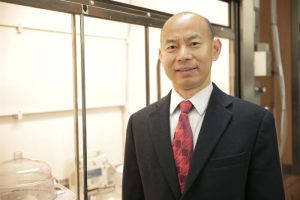3.1.18 | College of Engineering News | Natasha Kassulke

Zhenqiang “Jack” Ma, the Lynn H. Matthias Professor and Vilas Distinguished Achievement Professor in electrical and computer engineering at the University of Wisconsin-Madison, says it’s not uncommon for him to work late and sleep in his office.
He has a tendency to wake up at 3 a.m. when the answers to his research questions come to him. Working those hours has put Ma on track to be a serial innovator who has received more than 40 patents.
Ma has made distinguished contributions to the field of flexible electronics, particularly for inventing fast flexible electronics, flexible optoelectronics and nanomembrane-based photonics. But he has also worked to expand his applications in neuroscience and human pluripotent stem cell-based photoreceptor replacement.
Ma cites an impressive research infrastructure, excellent faculty and support for multidisciplinary collaborations as reasons he has been successful at UW-Madison.
In fact, he’s engaged in more than 60 collaborations during his 16 years at UW-Madison – half being with on campus researchers.
“Jack is a champion for collaborative research at UW-Madison,” says Norman Drinkwater, UW-Madison interim vice chancellor for research and graduate education. “His partnerships include on and off campus collaborators and the results of these meaningful connections are solving decades’ long problems, stoking the pace of research discovery, solidifying UW-Madison’s important role in innovation across disciplines, and moving the Wisconsin Idea forward. I commend Jack for his efforts to patent his innovations so that they can be brought to market and better impact people’s lives.”
One of those strong collaborations is with the Wisconsin Alumni Research Foundation. Ma recalls that shortly after he came to UW-Madison in 2002, he was approached by Stephanie Whitehorse, WARF Manager of IP Operations/Senior IP Manager, who explained the role of WARF and procedure for filing disclosure and next steps toward patenting.
“Jack is an exceptional researcher who is always teaching us something new,” says Whitehorse, who manages WARF intellectual property in the fields of biomedical engineering, medical physics, civil engineering, mechanical engineering, micro and nanotechnologies, materials and processing as well as electrical engineering, computer science and software. “He is a prolific inventor in his field and we are eager to see his innovations reach their full commercial potential.”
Ma has also served on the review board for UW-Madison’s Discovery to Product. Located within the Office of the Vice Chancellor for Research and Graduate Education, D2P provides a front door to entrepreneurs and innovators on campus to help them find and leverage resources, foster collaborations between UW-Madison and WARF, accelerate the commercialization of campus innovations, and to help transform the campus culture to cultivate entrepreneurship, start-ups and commercialization of innovations. D2P is located at 1403 University Ave.
In his role on the D2P oversight committee, he interviewed other universities to see how they accomplish the work that D2P does. What he discovered is the set up at other universities is different.
“We have D2P and WARF. WARF is dedicated to patents and filing licenses. D2P is dedicated to taking IP to the market,” he says. “That’s very unique among universities but creates a strong foundation for entrepreneurship.”
Ma recommends that others on campus who are looking to move their ideas forward talk to WARF about patenting and licensing early.
“Think about your papers before you publish them and ask if there is anything to be patented from it,” he says. “From there, talk to D2P. Working with WARF and D2P can save you time because they are the experts. There are lots of other resources on campus and WARF and D2P can help you connect to them and others off campus.”
“Commercialization of the ideas to come out of UW-Madison is good for society,” Ma says.
He says he thinks about the Wisconsin Idea a lot.
“I think many other universities could learn from the Wisconsin Idea. As a public university we are serving the public and I think doing it very well. WARF and resources like D2P are the ways to make the Wisconsin Idea happen. Sometimes we make a discovery, but we do not have an idea for the best application for it. But then we talk to a faculty member in the medical school or an area of engineering and find out they have been looking for that exact solution.”
A recent collaboration for Ma has been with David Gamm, associate professor of ophthalmology and visual sciences. Ma’s wife is UW-Madison Biomedical Engineering Professor Sarah Gong, and she helped make the connection with Gamm and is co-PI on their project, “Bioengineering Micro-Patterned Scaffolds for Human Pluripotent Stem Cell-Based Photoreceptor Replacement Therapies” to address degenerative vision loss.
“Commercialization takes time – and I don’t want to slow down the innovation part of my work right now,” Ma says. “I have to find a balance and right now I am networking and hoping to double my patent number over the next three to four years.”
But when he is ready to move his ideas to the marketplace, he knows the resources at here to help him.
“The patents that I have right now are very broad but the potential for commercialization is huge in the future,” he says. “Maybe in the next 40 years — by the time I’m 89, I will realize several more major breakthroughs. I want to leave a mark. That’s the drive for me. I never want to retire. This is my life.”